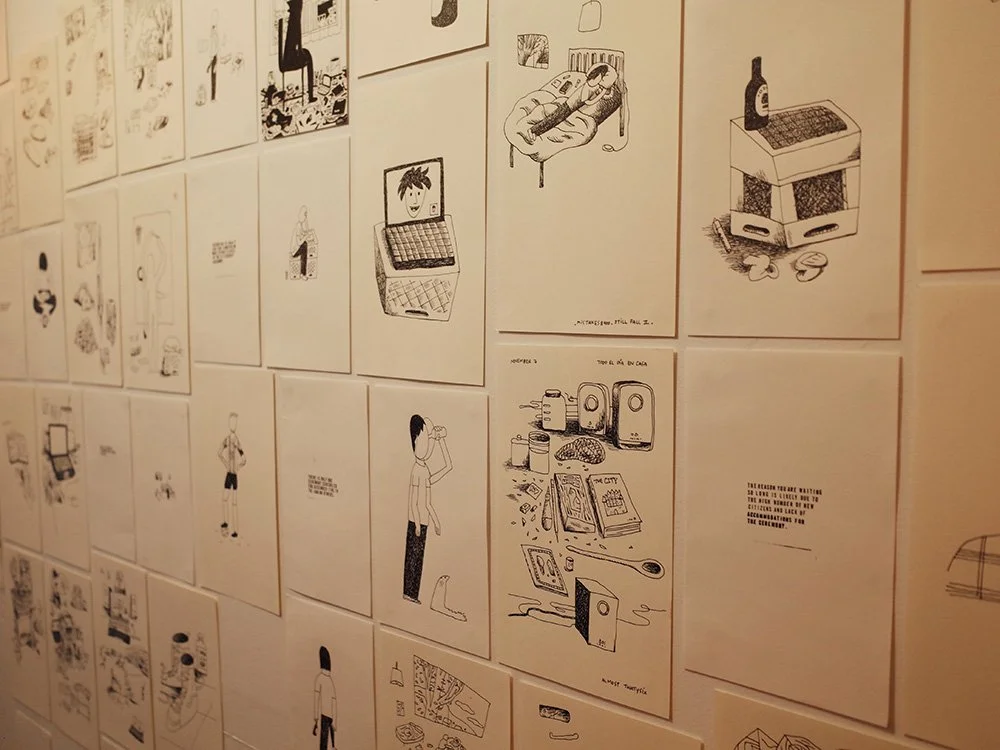Spotlight on JL González: (Un)Common Threads Creativity & Innovation Summit Artist-in-Residence
Some may think that creativity springs forth from divine intervention, or by being in the right place at the right time. Or we see "creativity" as a trait that a gifted few possess, and something we can never attain. But the truth is, we all exercise creativity in our daily lives and have the capacity to bring it forth. Sometimes, it's just a matter of making it a habit.
JL González knows this well. A visual artist, illustrator and author from Buenos Aires, who now calls rural Newfoundland home, his sketchbook is a constant companion that helps him get into the creative zone and revisit old ideas to gain new perspectives.
We connected with González (who is also the co-founder of Toporama Prints, a design, screen printing, and publishing studio based in English Harbour) to talk about how to make creativity a habit, how living in rural Newfoundland helps shape his work, and to dive deeper into the inspiration behind his upcoming installation "Beyond the Glass," which we're thrilled to present at our (Un)Common Threads Creativity & Innovation Summit on November 7. (The work, a blend of live animation and AR, focuses on ocean imagery and touches on traditional themes as it blends the old with the new, inviting participants to collectively be part of the creative process.)
JL González
Business & Arts NL: First, I'd like to ask you a little bit about your own creativity. When and where would you say you're most creative?
JL: Creativity is not about the perfect place or moment; it's an exercise in habit, shaped by consistent effort. Solutions to creative problems often come from working within boundaries that actually help ideas to flow, rather than stifle them. By making creativity a daily practice, you learn to generate inspiration, not wait for it. It's in this regular process of thinking, refining, and problem-solving that innovation thrives, regardless of where you are or when inspiration might strike.
Business & Arts NL: How do you tap into your creativity and conversely, what blocks your creativity? Is there anything you do in particular that helps you deal with mental/creative blocks or to help you get inspired when you're just not "feeling it"?
JL: I tap into my creativity by making it part of my everyday habits. I always carry a sketchbook, and when I don’t have it, my phone becomes a quick tool for gathering notes and ideas in the moment. I don’t wait for the "perfect" conditions; I start with what’s at hand, whether it's a thought, a visual, or a found object that sparks something. This practice helps me stay open to inspiration anytime, anywhere, without feeling blocked by external factors.
When I do hit creative blocks, I go back to my notes and sketches. Revisiting past ideas often brings fresh perspectives, and sometimes just the act of drawing or writing again, without any pressure, helps me work through those moments.
González has participated in art exhibitions such as “Long Ways,” a solo show at The Rooms.
Business & Arts NL: You've been living in Newfoundland since 2009 and you live in rural NL currently. What's it like creating here, compared to other places you've lived, and being part of the local arts scene? How does living in rural NL inspire you or inform your artistic practice?
JL: Living in rural Newfoundland, especially as someone from abroad, is a constant reminder of my sense of "otherness," but it has also given me a unique perspective that influences my creative work. Compared to other places I’ve lived, the rural environment here brings a different pace and a sense of isolation that deeply shapes my artistic practice.
Being part of the local arts scene, though, has been incredibly supportive. The sense of community I’ve found among peers and art institutions in Newfoundland and across Canada has given me a sense of belonging that really sustains me. Since moving from the city to the countryside, my work has shifted to explore broader themes like nationality and home. These themes question the fixed ideas we often have about identity and place, reflecting the complexities of my own experience of being between different cultures and geographies.
Business & Arts NL: What do you think the private sector has to gain from interacting with the arts sector?
JL: I feel like I live on both sides of this question, as I’m both an artist and a business owner. As an artist, I see how we often push boundaries, finding unconventional solutions without being too constrained by production, time, or money. This ability to think outside the box is something the private sector can really benefit from — whether it's in terms of innovation, problem-solving, or adding a fresh perspective to business challenges.
On the other side, when artists collaborate with business-minded people, it creates a powerful synergy. The structure and strategic thinking from the business world can provide valuable guidance for artists, helping to bring creative ideas to life in a sustainable way. A combination of these professions can lead to well-balanced projects that are both creatively ambitious and financially viable, allowing for new opportunities that neither sector could achieve alone.
JL’s exhibition of autobiographical ink drawings, titled “Killing Time,” took place in 2019 at Eastern Edge Gallery.
Business & Arts NL: "Beyond the Glass" is a very cool opportunity for summit participants to really "dive in" and get hands-on with an innovative art installation. What's the inspiration behind this installation?
JL: The inspiration behind Beyond the Glass started when I moved to rural Newfoundland and began working on large-scale drawings and paintings. I was struck by how impactful these larger pieces could be on any audience, whether they had an artistic background or not. When a friend gifted me a projector, initially for watching movies, I started experimenting with live drawing and outdoor projections, bringing my work to a scale I couldn’t reach otherwise.
For the summit, I wanted to expand on that idea by making it a collaborative experience. The installation combines drawing and animation, where participants can engage directly, learning the software and contributing to a communal, large-scale piece. The focus is on the process of creation, rather than on achieving perfection, and making something happen collectively.
I also wanted to touch on a traditional theme — ocean-related imagery — which is deeply connected to my life in rural Newfoundland and something I share with my neighbours, many of whom are involved in fishing. By blending this classic theme with a more technological approach, the installation brings together the local and the contemporary in a way that feels both personal and communal.




